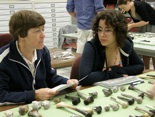A National Science Foundation Research Experiences for Undergraduates Site
Department of Anthropology, University of Notre Dame, Notre Dame, IN 46556

Guest Scientist
Prof. Brenda Baker has worked extensively with subadult human remains, publishing an often cited manual for the identification of children’s bones. She worked with each group to develop methods to reconstruct a demographic profile of the subadult segment of the Bab edh-Dhra’ collection.
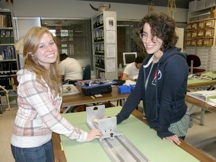
Elizabeth Studer [University of Colorado-Boulder] & Catalina Villamil [University of Pennsylvania]
We measured the vertical head diameter and mediolateral neck breadth of 56 left and 45 right femora from Bab edh-Dhra’ charnel house A22, dated to EBII-III, in order to estimate diaphyseal lengths using a regression equation. These lengths were used to place femora into one of five age categories (Fetal, Infant, Young child, Old child, Adolescent) based on either dental (Scale A) or functional (Scale B) development. Conservative ranges representing one standard deviation above and below a group mean were calculated using ten collections that included data on femoral length by age. Left femora were used for all demographic calculations, with N=48 for Scale A and N=46 for Scale B. This data was compared to eight groups as well as to other Bab edh-Dhra’ data. There was a significant difference with the four North American groups but not with the other comparative groups. When compared to subadult ages estimated from the mandible in A22, there was no significant difference (P-value = 0.5402, chi-value = 2.1583), indicating that we have a stable estimate of subadult age ranges for charnel house A22. When compared to subadult age estimates from the Bab edh-Dhra’ EBIA group, however, there were significant differences (P-value = 0.0001, chi-value = 22.9950), and the EBIA group clearly had many more fetal and infant remains and fewer old child remains. This may indicate interesting changes in cultural practices or health changes from EBIA to EBII-III, or simply preservation and conservation issues in the Bab edh-Dhra’ A22 charnel house.
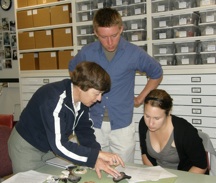
Let’s talk about sex: using metric and non-metric features of the subadult ilium to identify males and females in the Bab edh-Dhra’ collection, Charnel House A22
Robert Smith [Emory University] & Sarah Zaleski [Dickinson College]
The determination of subadult sex is a notoriously difficult task. This is because sexual dimorphism increases with age. Despite the associated complications, sexing subadult remains can provide much information about a population’s demography and burial practices. In this study, we analyze metric and nonmetric sexing techniques for subadult ilia of a commingled collection from Early Bronze Age II/III (3000-23500 BCE) Babe dh-Dhra’, Jordan. The collection comes from Charnel House A22. The four features we examined were auricular surface elevation, the arch criterion, the greater sciatic notch (GSN) angle, and the GSN depth. We analyzed GSN angle and depth using computer software ImageJ in order to obtain more accurate measurements and limit arbitrary factors. We assessed 61 right ilia. Using the multi-feature criteria, we classified the group as 54% male and 46% female. Using eleven multifeature combination models, we found no particular feature to be significantly different from our final sex determination. Eight out of the eleven models yielded concordance rates of 85% or higher when bones of indeterminate sex were excluded. However, we found that auricular surface is not as useful as the features of the greater sciatic notch. We believe that metric analysis can limit arbitrary factors associated with sexing subadults. We further suggest the use of multi-feature models as opposed to determination of sex from single ilial features. Our analysis of subadult sex in A22 has suggested no differential treatment of subadults by sex at EB II/III Bab edh-Dhra’.
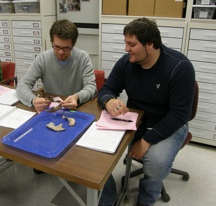
A Study of Linear Enamel Hypoplasias From the Dental Material of Bab edh-Dhra’, Jordan
Frank Vento [University of Notre Dame] & Grant Snitker [University of Oregon]
Sub-adult health is an important factor in understanding the overall health status and diet quality of archaeological skeletal collections. One method of assessing childhood health is an examination of linear enamel hypoplasias (LEH), which are the disruption in enamel growth on permanent dentition due to symptomatic stress events. LEHs were analyzed at the Early Bronze II/III site of Bab edh-Dhra in southern Jordan. A total of 59.9% of a sample of 277 permanent teeth showed at least one hypoplastic defect that corresponded to an age of occurrence range from 1.76 to 5.59 years. Comparisons to other regional sites shows that the Bab edh-Dhra’ prevalence rate is possibly unique to the Early Bronze Age II/III period. Future comparisons to earlier occupations of the site, a re-assessment of Bab edh-Dhra’ sub-adult remains, and Computed tomography (CT) scans of hypoplastic teeth may help to determine the possible causes for the development of dental enamel hypoplasias in the collection.
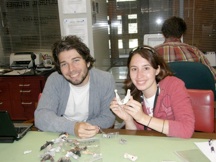
Aging the Mandible: Age Estimations of Bab edh-Dhra’ Subadults from Dental Eruption Patterns
Arianna DiMucci [Colorado College] & Sean McClellan [University of Chicago]
This study looked at dental eruption patterns and tooth/socket development in subadult mandibles dating to the Early Bronze II-III period. The skeletal collection, housed at the University of Notre Dame, was from charnel house A-22 at the site of Bab edh-Dhra’ – a site located along the Dead Sea Plain in Jordan. Overall, a biocultural approach was utilized in our analysis of the bones. Dental maturity stages, determined from the reading of relevant literature, were established to devise age estimations of the subadults. This, paired with comparative data from a variety of sites around the world and across different time periods revealed that younger individuals, e.g. ‘infants,’ made up a relatively small proportion of the subadult collection and were likely underrepresented. This could be due to a number of factors, including issues with preservation, shifting mortuary practices or changing demographic trends. Future research would likely benefit from the addition of a metric component to the study, a more narrow comparative focus, or the inclusion of a radiographic analysis.

Aging the Subadult Collection at the Early Bronze Age site of Bab edh-Dhra’: The Occipital and the Scapula
Katie Schurr [Beloit College] & Casey Sulivan [University of Notre Dame]
By aging the pars basilars of the occipital bone and the glenoidal surface of the scapula and looking at the distribution of ages across both of these bones, preliminary estimations about subadult demography at the Early Bronze Age II –III site of Bab edh-Dhra’ was analyzed.
\


Previous NSF-REU Summers
A summary of previous research projects can be found:




